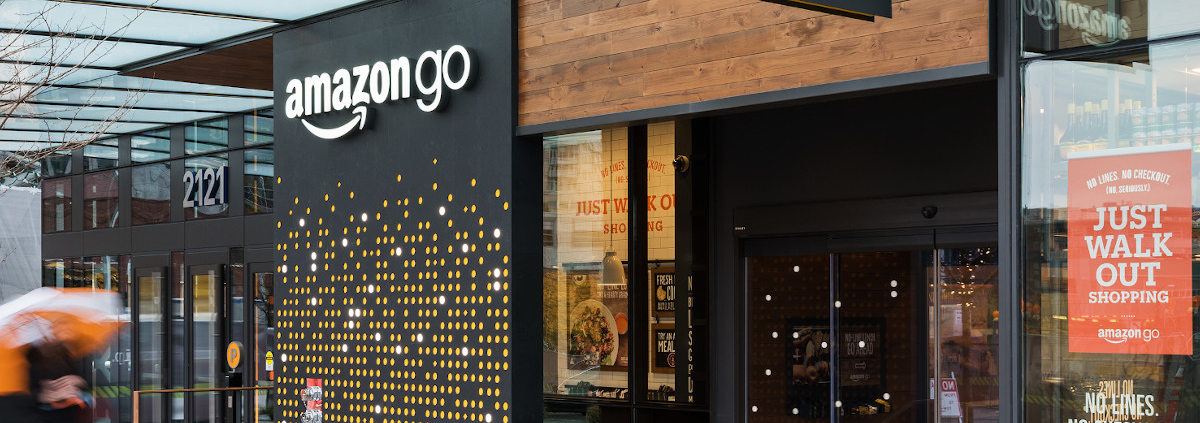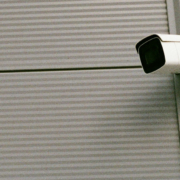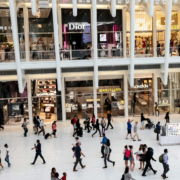Amazon Go – the cashierless pioneer
“If you double the number of experiments you do per year you’re going to double your inventiveness.” – Jeff Bezos
What started as a big experiment in 2015, nowadays is cashierless experience at its best. Several Amazon executives conceptualized and tested the technology in a that time secret warehouse. Currently Amazon operates 27 physical Amazon Go convenience stores across the US and is planning to go international, with a focus on UK.
No need to wait in line ever again
Here’s how Amazon Go sums it up.
Choose what you like: Just walk in the store and pick the items you are looking for.
Bag as you shop: Yes you heard right, that’s not called shoplifting. Once you bagged the products, you won’t have to touch them again before arriving home.
Just walk out: You might be used to it, but there’s really no need to wait in line. Just leave the store without ever passing a cashier.
Receive an email receipt: OK, you still have to pay. But without wasting time queuing for it. The money will be deducted from your preferred payment method via the Amazon app automatically.
As one of the biggest companies in the world, Amazon created an own name for its cashierless technology: “Amazon Go & Just walk out” shopping experience.
What exactly is an Amazon Go store?
The first Amazon Go stores were more of a corner convenience store. Only 1,800 square feet (170 m2) “big” and technically couldn’t handle much more of 20 shoppers at the same time. In 2020 Amazon more than quintupled that size with the opening of a 10,400 square feet (970 m2) Amazon Go grocery store in Seattle. And of course, there is no communicated limitation in shoppers anymore.
When you enter an Amazon Go store you will be surprised by how clean and modern it looks. At first sight, most people wouldn’t even recognize all the technical equipment running the store. You can buy everything from fruits to drinks and household equipment. Most shoppers will have gotten in touch with Amazon before and won’t need to worry too much about setting up their mobile phone with their first visit. There used to be a special Amazon Go app, but Amazon recognized this limiting factor and shoppers can now simply process their purchase through the main Amazon app. So, no need to set up a special app and payment anymore. It’s all linked to your main Amazon account.
You might wonder to see “Amazon Go” and “Amazon Go Grocery”. Both types of stores use the same technology but differ in what they offer. While Amazon Go mainly serves breakfast, lunch and small on-the-go items, Amazon Go Grocery is the grown up. It’s comparable to any fully equipped grocery store and much larger as explained above.
What technology does Amazon Go use?
As always with big tech, it’s not that easy to find out what’s the exact recipe. Once you enter one of their stores you will recognize all kinds of sensors, cameras and other technical equipment. Most of that is fixed to the dark ceiling, but not only. All that technology has only one purpose: To detect what exactly you put in your shopping bag. What is interesting is that it’s a combination of several technologies. Similar to Mercedes not only wanting to rely on cameras for autonomous driving – in sharp contrast to Tesla.
With the opening of the first Amazon Go store, there were several limitations. To process all the data, Amazon uses computing power and artificial intelligence. While computing power was not close to what is today, artificial intelligence needs to be fed with a lot of data to work properly. Obviously the first stores had their limitations in what kind of customer action they could process. Even though nowadays there’s still room for improvement. You will recognize that, once you take an item from the shelf, put it into your bag, take it out again, put it back to the shelf, take it again, hide it with your jacket and finally decide not to buy. On your way back home, you still might find that item billed to your account.
As Amazon is an extremely customer-focused company one call or a short chat will fix that. But you get it. The more complex the movements, the more confused the system. No doubt these bugs will keep being fixed. And keep in mind that a human cashier makes mistakes as well, probably many more.
How does the Just walk out thing work?
Even though it feels weird at first, it’s probably one of the easier parts to understand. As all the work has been done while shopping, there is just no need for a human cashier anymore. Your virtual shopping cart is a clone of your physical cart and you don’t need to worry about queuing. The fun part is leaving a store during rush hour immediately after having picked up all items on your shopping list. It not only saves time, but also makes shopping much smoother. And no more cutting in line.
What about payment?
There is not such thing as free shopping, not even in the Amazon world. Even though you might have redeemed one or two coupons, soon after having left the store you will receive a shopping receipt, best accessed via the app. This does not differ much to any online purchase on amazon.com. You can carefully check all items billed and have the option to raise an issue via a simple click on any item. Like online, your bill will be deducted from your linked payment method.
The human factor
As we outlined in this article, many people expect to see a completely deserted store. These stores exist, especially in Asia, but commonly are much smaller. Employees are still needed, but jobs are shifting. Not considering the technical part, on-site staff is needed to stock shelves, for security and to answer shoppers’ questions.
I also want to discover Amazon Go
You might be out of luck if living outside the US. Amazon has big plans for international expansion but just isn’t there yet. You are more lucky if living in the UK.
Don’t keep looking for Amazon Go though. In London there are 19 cashierless Amazon stores running under “Amazon Fresh”. According to MarketingWeek Amazon is pausing its aggressive UK rollout due to little competitive edge. With a minimart at every corner, queuing seems to be a minor problem and consumers are opting for the cheapest option. Privacy concerns are another major issue in Europe.
The downside
Happy customers all over the world enjoying a new, convenient way of shopping. Not just yet. Like so many recent innovations, cashierless technology and especially Amazon Go have their downsides. A huge venture owning all the customer data, knowing what moves you online and now even offline. Every purchase linked to one ID, one payment method, one account. Especially in Europe consumers have a strong sense for privacy. With governments all over the world trying to limit the power of these global corporations.
Furthermore, shoppers need to have a certain access to technology. No chance to go shopping without a mobile phone and a working payment method. No chance to go shopping with a blocked Amazon account. To protect low-income people from potential discrimination, Philadelphia, San Francisco and New Jersey have passed legislation banning stores and retailers only allowing cashless payment.
Last but not least imagine the Amazon servers got hacked or a store got hit by a local power blackout.
Amazon will keep on delivering
Innovation always comes with risk. But with customers becoming more and more demanding the benefits outweigh the risks. Most shoppers entering an Amazon Go store are already loyal customers and enjoy the technological progress. They are part of a worldwide movement of people expecting the best, from themselves and their service providers. Competition will increase with global demand. And more options mean more decision power for consumers.
Amazon as a company will and has to keep on learning to stay ahead. What’s next?







